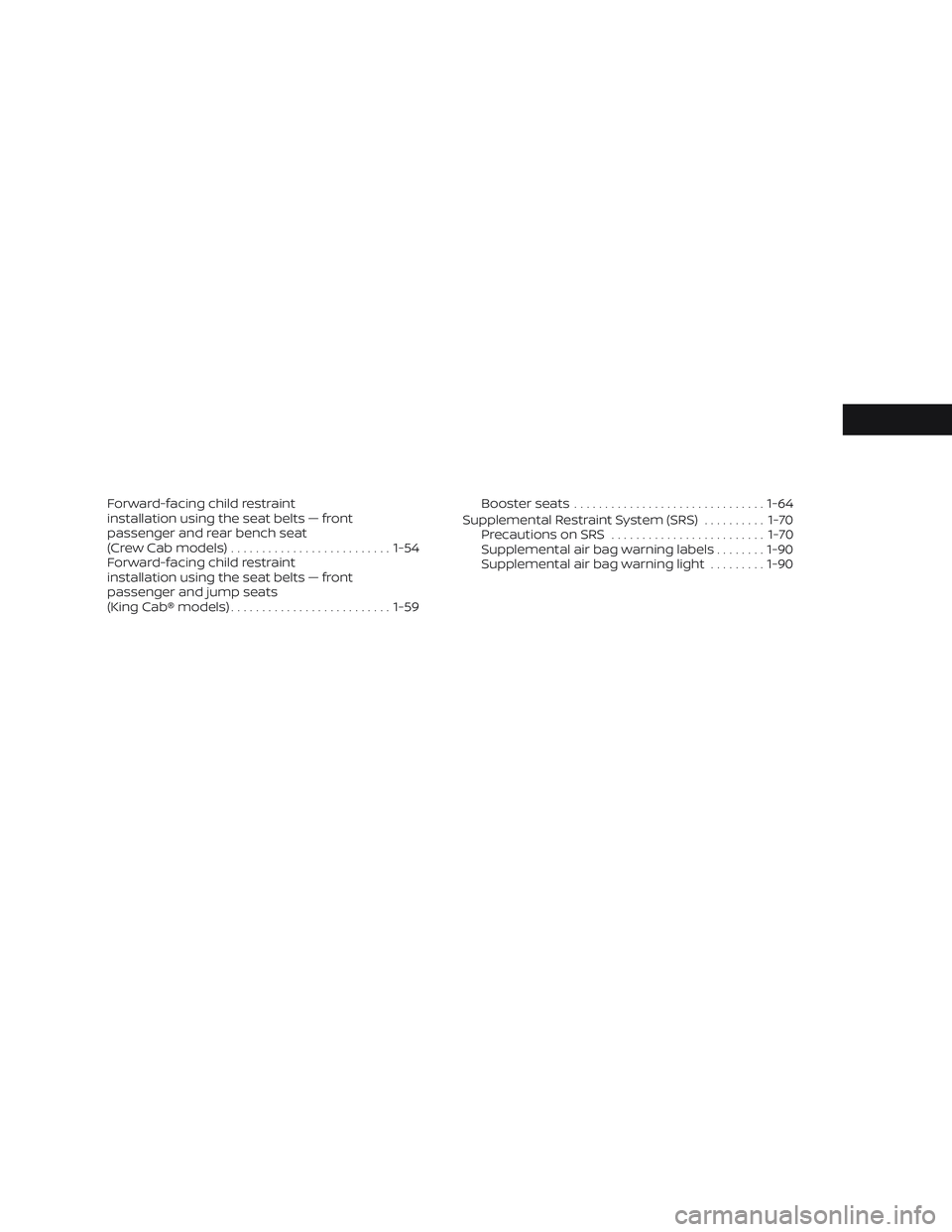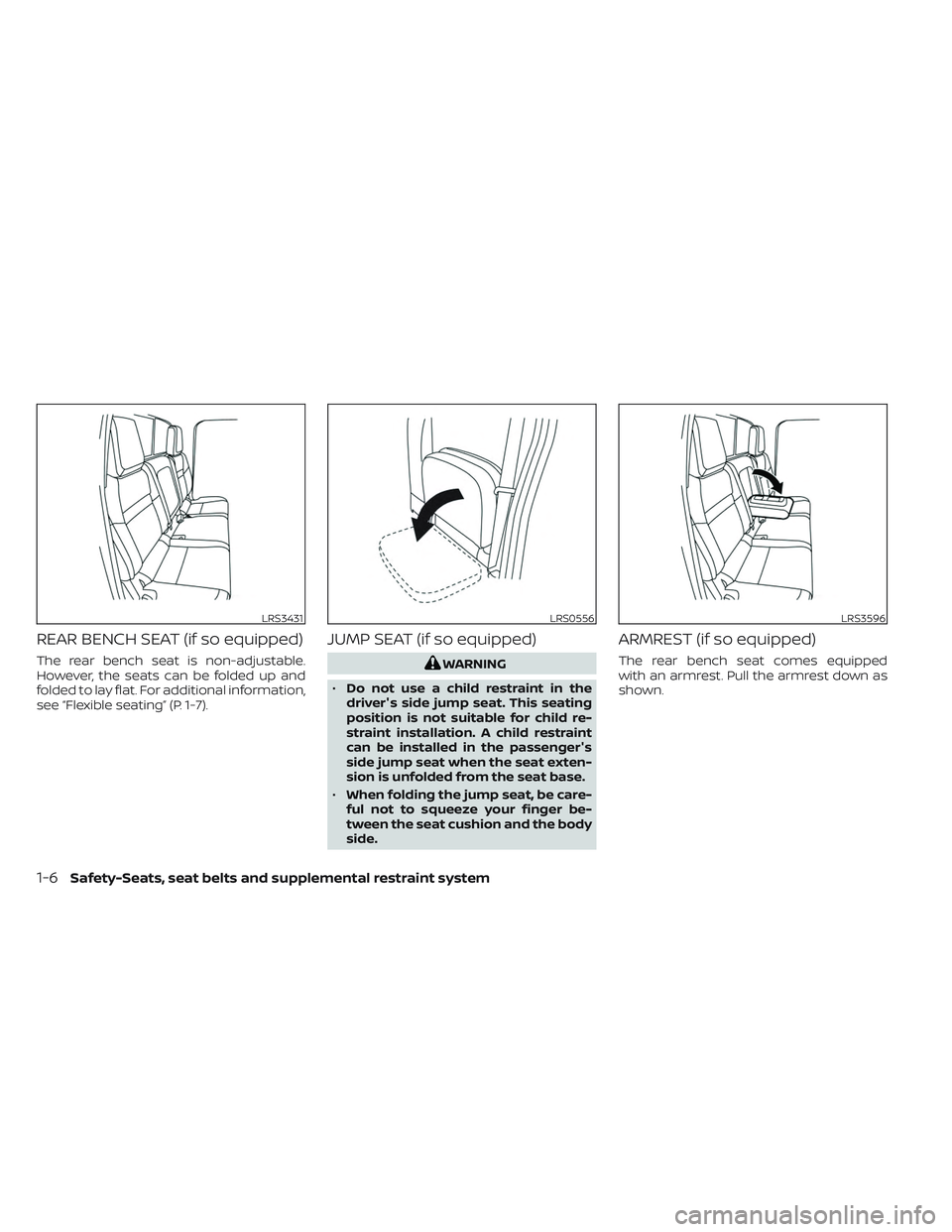2023 NISSAN FRONTIER child restraint
[x] Cancel search: child restraintPage 3 of 572

This manual was prepared to help you un-
derstand the operation and maintenance
of your vehicle so that you may enjoy many
miles (kilometers) of driving pleasure.
Please read through this manual before
operating your vehicle.
A separate Warranty Information Book-
let explains details about the warranties
covering your vehicle. The “Maintenance
and schedules” section of this manual
explains details about maintaining and
servicing your vehicle. Additionally, a
separate Customer Care/Lemon Law
Booklet (U.S. only) will explain how to
resolve any concerns you may have with
your vehicle, and clarif y your rights un-
der your state's lemon law.
When you require any service or have any
questions, a NISSAN dealer will be glad to
assist you with the extensive resources
available to them.
In addition to factory-installed options,
your vehicle may also be equipped with
additional accessories installed prior to de-
livery. It is recommended that you visit a
NISSAN dealer for details concerning the
particular accessories with which your ve-
hicle is equipped. It is important that you
familiarize yourself with all disclosures,
warnings, cautions and instructions con-cerning proper use of such accessories
prior to operating the vehicle and/or ac-
cessory. It is recommended that you visit a
NISSAN dealer for details concerning the
particular accessories with which your ve-
hicle is equipped.
Before driving your vehicle, please read this
Owner's Manual carefully. This will ensure
familiarity with controls and maintenance
requirements assisting you in the safe op-
eration of your vehicle.
WARNING
IMPORTANT SAFETY INFORMATION
REMINDERS!
Follow these important driving rules to
help ensure a safe and comfortable trip
for you and your passengers!
• NEVER drive under the influence of
alcohol or drugs.
•
ALWAYS observe posted speed limits
and never drive too fast for conditions.
• ALWAYS give your full attention to
driving and avoid using vehicle fea-
tures or taking other actions that
could distract you.
• ALWAYS use your seat belts and ap-
propriate child restraint systems.
Pre-teen children should be seated in
the rear seat.
• ALWAYS provide information about
the proper use of vehicle safety fea-
tures to all occupants of the vehicle.
• ALWAYS review this Owner’s Manual
for important safety information.
FOREWORD READ FIRST—THEN DRIVE SAFELY
Page 11 of 572

0 Illustrated table of contents
Air bags, seat belts and child restraints..........0-2
Exterior front ....................................0-3
Exterior rear .....................................0-4
Passenger compartment .......................0-5 Instrument panel
................................0-6
Engine compartment check locations ...........0-8
Warning and indicator lights ....................0-10
Page 12 of 572

1. Rear outboard seat belts with preten-sioner(s) (P. 1-89)
2. Roof-mounted curtain side-impact and
rollover supplemental air bag (P. 1-86) 3. Head restraints/headrests (P. 1-9)
4. Front outboard seat belts with shoulder
height adjuster and pretensioner(s)
(P. 1-18, 1-22, 1-89) 5. Supplemental front-impact air bags
(P. 1-70)
6. Driver supplemental knee air bag
(P. 1-87)
Front passenger supplemental knee air
bag (P. 1-87)
7. Seats (P. 1-2)
8. Occupant classification sensor
(weight sensor) (P. 1-70)
9. Front seat-mounted side-impact
supplemental air bag (P. 1-70)
10. LATCH (Lower Anchors and Tethers for
CHildren) system (P. 1-28)
11. Top tether strap anchor (P. 1-31)
Refer to the page number indicated in
parentheses for operating details.
LII2734
AIR BAGS, SEAT BELTS AND CHILD
RESTRAINTS
0-2Illustrated table of contents
Page 22 of 572

1 Safety-Seats, seat belts and
supplemental restraint system
Seats............................................ 1-2Front manual seat adjustment
(if so equipped) ................................1-3
Front power seat adjustment
(if so equipped) ............................... 1-4
Rear bench seat (if so equipped) ............. 1-6
Jump seat (if so equipped) ................... 1-6
Armrest (if so equipped) ...................... 1-6
Flexible seating ................................1-7
Head restraints/headrests ...................... 1-9
Adjustable head restraint/headrest
components ................................. 1-11
Non-adjustable head restraint/
headrest components .......................1-11
Remove...................................... 1-11
Install ........................................ 1-12
Adjust ........................................ 1-12
Seatbelts ....................................... 1-14
Precautions on seat belt usage ...............1-14
Seat belt warning light and chime ............1-17
Pregnant women ............................ 1-17
Injured persons .............................. 1-17
Three-point type seat belt with
retractor ..................................... 1-18
Seat belt extenders ......................... 1-22Seat belt maintenance
......................1-23
Child safety .................................... 1-23
Infants ...................................... 1-24
Small children ............................... 1-24
Larger children .............................. 1-25
Child restraints ................................. 1-26
Precautions on child restraints ..............1-26
LATCH (Lower Anchors and Tethers for
CHildren) system ............................ 1-28
Rear-facing child restraint installation
using LATCH (Crew Cab models) .............1-32
Rear-facing child restraint installation
using LATCH — jump seat (King Cab®
models) ..................................... 1-34
Rear-facing child restraint installation
using the seat belts (Crew Cab models) .....1-38
Rear-facing child restraint installation
using the seat belts — jump seat
(King Cab® models) ........................... 1-41
Forward-facing child restraint
installation using LATCH
(Crew Cab models) .......................... 1-45
Forward-facing child restraint
installation using LATCH — jump seat
(King Cab® models) .......................... 1-49
Page 23 of 572

Forward-facing child restraint
installation using the seat belts — front
passenger and rear bench seat
(Crew Cab models).......................... 1-54
Forward-facing child restraint
installation using the seat belts — front
passenger and jump seats
(King Cab® models) .......................... 1-59Booster seats
............................... 1-64
Supplemental Restraint System (SRS) ..........1-70
Precautions on SRS ......................... 1-70
Supplemental air bag warning labels ........1-90
Supplemental air bag warning light .........1-90
Page 24 of 572

WARNING
• Do not ride in a moving vehicle when
the seatback is reclined. This can be
dangerous. The shoulder belt will not
be against your body. In an accident,
you could be thrown into it and re-
ceive neck or other serious injuries.
You could also slide under the lap belt
and receive serious internal injuries. •
For the most effective protection
when the vehicle is in motion, the
seat should be upright. Always sit
well back and upright in the seat with
both feet on the floor and adjust the
seat properly. For additional infor-
mation, see “Precautions on seat belt
usage” (P. 1-14).
•
Af ter adjustment, gently rock in the
seat to make sure it is securely locked.
• Do not leave children unattended in-
side the vehicle. They could unknow-
ingly activate switches or controls or
make the vehicle move. Unattended
children could become involved in
serious accidents.
• To help avoid risk of injury or death
through unintended operation of the
vehicle and/or its systems, do not
leave children, people who require
the assistance of others or pets unat-
tended in your vehicle. Additionally,
the temperature inside a closed ve-
hicle on a warm day can quickly be-
come high enough to cause a signifi-
cant risk of injury or death to people
and pets.
• Do not adjust the driver’s seat while
driving so full attention may be given
to vehicle operation. The seat may
move suddenly and could cause loss
of control of the vehicle.
•
The seatback should not be reclined
any more than needed for comfort.
Seat belts are most effective when the
passenger sits well back and straight
up in the seat. If the seatback is re-
clined, the risk of sliding under the lap
belt and being injured is increased.
ARS1152
SEATS
1-2Safety-Seats, seat belts and supplemental restraint system
Page 28 of 572

REAR BENCH SEAT (if so equipped)
The rear bench seat is non-adjustable.
However, the seats can be folded up and
folded to lay flat. For additional information,
see “Flexible seating” (P. 1-7).
JUMP SEAT (if so equipped)
WARNING
• Do not use a child restraint in the
driver's side jump seat. This seating
position is not suitable for child re-
straint installation. A child restraint
can be installed in the passenger's
side jump seat when the seat exten-
sion is unfolded from the seat base.
• When folding the jump seat, be care-
ful not to squeeze your finger be-
tween the seat cushion and the body
side.
ARMREST (if so equipped)
The rear bench seat comes equipped
with an armrest. Pull the armrest down as
shown.
LRS3431LRS0556LRS3596
1-6Safety-Seats, seat belts and supplemental restraint system
Page 31 of 572

1. Pull strap
2. Child restraint anchor points
Folding the rear bench seat down
(if so equipped)
The rear bench seatback can be tilted for-
ward to access the child restraint anchor
point locations or the jacking equipment.
To tilt the seatback forward, pull the pull
strap up and tilt the seatback. The child
restraint anchor points can be accessed
behind the rear bench seatback. The jack-
ing equipment can be accessed from be-
hind the passenger’s side seatback..
WARNING
Never allow anyone to ride in the cargo
area or on the rear seat when it is in the
fold-down position. Use of these areas
by passengers without proper re-
straints could result in serious injury or
death in an accident or sudden stop.WARNING
Head restraints/headrests supplement
the other vehicle safety systems. They
may provide additional protection
against injury in certain rear end colli-
sions. Adjustable head restraints/
headrests must be adjusted properly,
as specified in this section. Check the
adjustment af ter someone else uses
the seat. Do not attach anything to the
head restraint/headrest stalks or re-
move the head restraint/headrest. Do
not use the seat if the head restraint/
headrest has been removed. If the head
restraint/headrest was removed, rein-
stall and properly adjust the head
restraint/headrest before an occupant
uses the seating position. Failure to fol-
low these instructions can reduce the
effectiveness of the head restraints/
headrests. This may increase the risk of
serious injury or death in a collision.
LRS3434
HEAD RESTRAINTS/HEADRESTS
Safety-Seats, seat belts and supplemental restraint system1-9